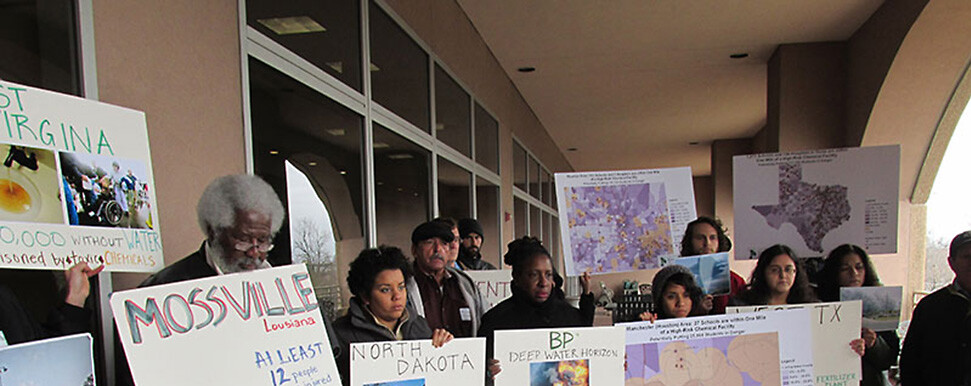
Media
June 23, 2016When It Comes To Protecting Public Health From Toxic Chemicals, TSCA Reform Leaves Much Unfinished Business
***For Immediate Release: June 23rd, 2016****
[Washington, DC] – In response to President Obama signing the ’Frank R. Lautenberg Chemical Safety for the 21st Century Act' into law, Judy Robinson, Co-Director of Coming Clean, a collaborative network of over 200 community and environmental health organizations, issued the following statement:
“Although we desperately need to update our nation’s 'Toxic Substances Control Act of 1976' (TSCA) to address public health problems caused by today’s ubiquitous chemical exposures, Congress’s most recent effort falls far short of the protections families and at-risk communities deserve. The Lautenberg Chemical Safety Act does make some important improvements to our current toxic chemical regulations, however, this is a low bar to clear given that our preceding rules failed to ban even the most dangerous substances such as asbestos and dioxin. Today, while the din of self-congratulation still resonates, we ask Congress-members to take stock of the communities still in danger—and the work yet to be done—to ensure that every child grows up free from birth defects or learning disabilities and every adult need not worry about cancer or health problems related to toxic chemical exposures.”
The following are statements by lead environmental health and justice organizations working within the Coming Clean collaborative:
Vi Waghiyi, Health and Justice Program Director of Alaska Community Action on Toxics, said," Our indigenous peoples in Alaska and the Arctic have some of the highest exposures to persistent bio-accumulative toxics (PBTs) of any population on the planet. We suffer disproportionate health harms including cancers, birth defects and learning and developmental disabilities, but this action by Congress doesn’t require equal protection of our community—leaving our lands, waters and the health and well-being of our people in danger.”
Michele Roberts, Co-Director of the Environmental Justice Health Alliance, said, “Serious chemical safety reform would protect the health of all people—and especially those who live in ‘hot spots’ or ‘sacrifice zones’ which are highly impacted by chemical factories, and typically communities of color or low-income communities. We hope that Congress will pay attention to the struggles faced by communities on the front-lines of toxic chemical exposure from industrial facilities or waste dumps—and take further steps to ensure protections for all Americans.”
Jose Bravo, Coordinator of the Campaign for Healthier Solutions (the 'Dollar Store Campaign'), said, “Our campaign is seeking to protect workers, people of color and low-income families from the toxic chemicals commonly found in products sold at dollar stores and other discount retailers. Unfortunately, in this bill, Congress actually took steps to restrict the oversight of toxic chemicals in imported products. This baffling action puts every family at risk of increased exposure to dangerous chemicals in household goods, and most especially people of color and low-income communities who often work and shop at dollar stores.”
David Levine, CEO and co-founder of the American Sustainable Business Council (ASBC), said, “This compromise strengthens EPA’s authority to protect Americans from dangerous chemicals, but it falls short in many ways. The Companies for Safer Chemicals coalition worked hard to improve the safety and transparency provisions in the original Senate bill, which was written to protect the legacy chemical producers.”
Ted Schettler, Science Director for the Science and Environmental Health Network, said, “The new law falls short of protecting public health in a number of important ways. But now, we will be carefully watching to see that EPA’s implementation follows recommendations from the National Academy of Sciences for improving assessment of risks in order to truly protect people who are most highly exposed and most susceptible. And, hazardous chemicals must not be allowed to slip through regulatory cracks because of lack of information and use of non-validated test methods, resulting in a free pass.”
Together, these groups and many others gathered in 2004 to incorporate the Louisville Charter for Safer Chemicals, A Platform for Creating a Safe and Healthy Environment through Innovation. This is a definitive guide to just and protective hazardous chemical policy. The Charter includes these principles as part of any sufficient chemical management policy:
- Require safer substitutes and solutions;
- Phase out persistent, bioaccumulative or highly toxic chemicals;
- Give the public and workers the full right to know;
- Act on early warnings;
- Require comprehensive safety data on all chemicals;
- Take immediate action to protect communities and workers.
The ’Frank R. Lautenberg Chemical Safety for the 21st Century Act' fails to adequately meet these standards and therefore fails the charge to urgently protect the public from exposure to known and suspected toxics.
Judy Robinson, Co-Director of the Coming Clean collaborative, said, “Despite Congress’s recent action, the urgent job of identifying and sharing all the industrial chemicals workers and the public are exposed to, and driving reforms to mandate safer alternatives, will remain a critical focus of environmental health scientists, activists, advocates, and supporters. We hope that Congress will return to this critical work soon, and enact sorely needed protections from hazardous chemicals to ensure the health of our children, vulnerable populations, and all Americans for generations to come.”
Available for Comment
Eric Whalen; Communications Coordinator, Coming Clean; (971) 998-8786, ericwhalen@comingcleaninc.org.
